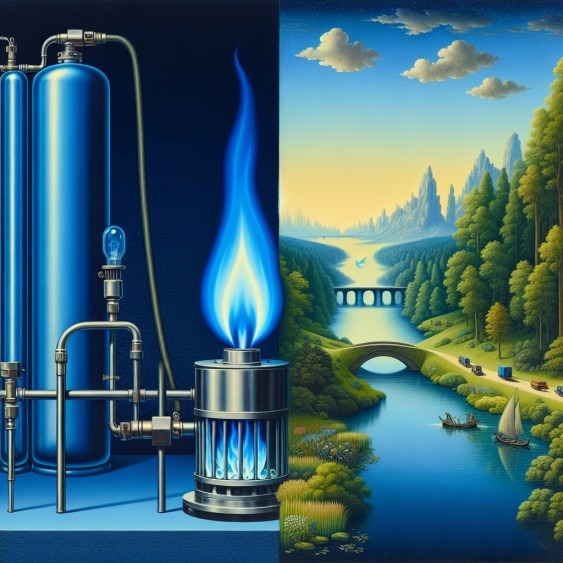Unveiling the Mystery: What Is Blue Gas?
Updated: April 14, 2024
Blue gas, or blue hydrogen, has sparked interest as a low-carbon energy alternative. Produced from natural gas through steam methane reforming (SMR), blue hydrogen captures and stores carbon emissions, reducing its environmental impact.
Stepping Stone to Green Hydrogen: Blue hydrogen is a crucial transitional step towards a green hydrogen economy. Its current economic advantages over green hydrogen, produced via electrolysis and renewables, make it an attractive short-to-medium-term option for countries and industries aiming to lower carbon emissions.
Governmental Strategies: Several governments have included blue hydrogen in their energy transition plans. For example, the UK supports a “twin-track” approach, while Canada leverages its natural gas reserves and carbon capture and storage (CCS) technology to invest in blue hydrogen.
Corporate Investments: Major energy companies like BP, Shell, and Equinor also embrace blue hydrogen. BP, for instance, plans to establish a blue hydrogen production facility in the UK by 2027.
The Challenges and Controversies
Energy Intensity and Emissions: Producing blue hydrogen is energy-intensive, and carbon capture and storage technologies are not 100% effective. Methane leakage during natural gas extraction can also offset the carbon benefits of blue hydrogen.
Green Hydrogen’s Rising Competitiveness: The falling costs of renewable energy and electrolysis technologies make green hydrogen increasingly competitive. Critics argue that investing in blue hydrogen could divert resources from green hydrogen, which offers a more sustainable long-term solution.
Environmental Concerns: While marketed as a clean alternative, blue hydrogen’s environmental benefits are debated. Studies show carbon capture rates are often below 100%, resulting in greenhouse gas emissions. Additionally, methane leakage during natural gas extraction and transportation further contributes to its climate impact.
Blue hydrogen presents a complex landscape of opportunities and challenges as the world navigates the energy transition. Further research and advancements are needed to enhance its efficiency and reduce emissions. With its direct reliance on renewables, green hydrogen may offer a more sustainable path forward.
Crafting Blue Gas: Unveiling the Intricacies
Blue hydrogen, a low-carbon energy alternative, is produced through steam methane reforming (SMR) on an industrial scale. This process utilizes natural gas as feedstock, combined with steam, at high temperatures (700-1100 °C) to generate hydrogen and carbon monoxide. As of 2023, approximately 75-78% of global hydrogen production relies on natural gas for SMR, making it the cheapest source of industrial hydrogen.
The carbon monoxide produced in the initial reaction is then converted into additional hydrogen and carbon dioxide through the water-gas shift reaction. To achieve its “blue” status and reduce carbon emissions, carbon capture and storage (CCS) technology is employed to capture and store the carbon dioxide emissions underground.
However, CCS is not 100% effective, with capture rates ranging from 85% to 95% for blue hydrogen production. Additionally, methane leaks during natural gas extraction and transportation can further reduce the climate benefits of blue hydrogen. Studies indicate that blue hydrogen has a larger carbon footprint than initially marketed, and its environmental benefits depend on the source of electricity used in production.
While blue hydrogen presents an intriguing alternative, it faces challenges and limitations. As of 2024, only a handful of commercial blue hydrogen facilities are in operation. The development of blue hydrogen infrastructure, including refuelling locations, contributes to high costs, impacting its accessibility and viability as a widespread alternative fuel.
Renewable energy sources, such as solar and wind power, must be utilized in production to reduce carbon emissions and achieve carbon neutrality. This shift would enhance the sustainability of blue hydrogen and reduce its overall environmental impact.
The Feasibility of Blue Gas: Exploring the Reality
The discussion around blue gas, or blue hydrogen, as a sustainable fuel source is multifaceted. While it offers a promising route to reducing emissions, particularly in hard-to-abate sectors, it also presents challenges and opportunities that must be addressed.
The Investment Landscape:
– Subsidy Requirements: Scaling up renewable hydrogen technologies requires significant investment. Bloomberg New Energy Finance (BNEF) estimates that governments may need to provide approximately $150 billion in subsidies over the next decade to support the development and deployment of these technologies.
– Economic Impact of COVID-19: The global economic fallout from the coronavirus pandemic has constrained government finances, potentially impacting their ability to allocate substantial funds towards long-term sustainability initiatives like renewable hydrogen projects.
Market Dynamics: As economies recover, the transition to sustainable fuels remains a priority. Electric vehicles, for instance, continue to gain traction, and Tesla’s stock performance reflects investor confidence in this sector.
Blue Gas vs. Electric Trucks:
– Electric Truck Advantage: Research suggests electric trucks with a 400-kilometre range outperform diesel and hydrogen trucks. Electric motors near the wheels reduce weight, and advancements in battery technology address range and charging concerns.
– Infrastructure Considerations: Expanding charging infrastructure for electric trucks is ongoing, and collaboration between stakeholders is crucial to overcoming limitations.
Blue Gas Hype vs. Reality:
– Market Dynamics: The hype around blue gas as a “Tesla challenger” should be critically evaluated. Tesla’s stock performance and the broader shift towards electric vehicles indicate that the market favours cleaner transportation options.
Emissions and Sustainability: Blue gas faces emissions, production efficiency, and overall sustainability challenges. Using renewable energy sources in production is essential to reducing carbon emissions and achieving true sustainability.
Tesla’s Future: Navigating Challenges and Opportunities
Tesla, a pioneer in the electric vehicle (EV) industry, has experienced profitability, with a net income of $105 million in Q4 2019. However, the highly competitive automotive industry and market dynamics present ongoing challenges. Tesla’s success hinges on maintaining profitability, innovation, and adaptability.
The economic impact of the coronavirus pandemic has influenced government priorities and financial constraints, potentially affecting the availability of subsidies for alternative fuel technologies like blue gas. This may impact the development and adoption of sustainable fuels, including EVs.
Blue Gas vs EVs:
Blue gas, or hydrogen fuel cells, has gained attention but faces challenges. The production cost is higher than that of conventional fuels, and the lack of a widespread refuelling network is a significant hurdle. In contrast, according to Fortune Business Insights, the global EV charging stations market is projected to reach USD 264.80 billion by 2026, favouring EV adoption.
Supercharging the EV Revolution:
Tesla’s Supercharger Stations (1,971 stations and 17,467 Superchargers) offer convenient and fast charging, enhancing EV usability. However, blue gas proponents face the task of addressing production and infrastructure challenges to compete with the established EV charging network.
While blue gas is promoted as a “battery killer,” it is essential to consider its limitations. Hydrogen fuel cells require space and infrastructure, and their production can have environmental impacts. The success of EVs, as evidenced by Tesla’s performance, indicates a market preference for cleaner, more sustainable options.
Conclusion: Blue Gas and the Future of Clean Transportation
Blue gas, or blue hydrogen, has potential as a cleaner fuel alternative, but it faces significant challenges in the well-established electric vehicle (EV) industry. As of 2024, here are the key considerations:
– Emissions: Blue gas emits less carbon dioxide than traditional gasoline but cannot achieve the absolute zero-emission standard of EVs, primarily when powered by a greening energy grid.
– Infrastructure: The global expansion of EV charging stations offers convenience and accessibility to EV drivers. In contrast, blue gas fueling stations are limited, hindering its widespread adoption.
Cost: Establishing blue gas fueling stations is substantial compared to the relatively cost-effective expansion of EV charging infrastructure.
– Market Dynamics: The EV industry continues to evolve, with advancements in battery technology and vehicle design. A key player, Tesla has led the way in EV innovation and market presence.
– Policy Support: The transition to sustainable fuels is a global priority. Government subsidies and policies can influence the development and adoption of blue gas and EV technologies.
In conclusion, while blue gas holds promise, it faces an uphill battle against the established EV industry. The future of clean transportation will be shaped by ongoing technological advancements, market dynamics, and policy support for sustainable alternatives.
Random Reflections on the Stock Market
Since abandoning the gold standard, the lack of backing for our money has led to corruption and unethical practices. With the increase in money supply, moral values have declined, leading to a disregard for human life. Money has become the sole focus, and the Federal Reserve deliberately creates boom and bust cycles by manipulating interest rates.
They are indifferent to the consequences of inflation or deflation and even initiate actions that contribute to these issues. Understanding this truth opens the possibility of delving deeper into the matter. However, true change will only occur when the masses rise and revolt. Mass psychology shows that people only awaken when they are on the brink of disaster, at which point they can do nothing but protest.
Taking a step back and adopting a more comprehensive perspective reveals influential individuals’ intricate web of influence. They manipulate crucial sectors like the media, healthcare, and the military-industrial complex to shape a distorted reality that serves their interests. This control extends even further, permeating the fabric of society and influencing the narratives that shape our collective understanding.
Approximately 75% of individuals face significant challenges from the moment they are born. Factors beyond their control limit their opportunities and disadvantage them, perpetuating a cycle of hardship and inequality.
Engaging Mind Treats

Inflation vs Deflation: What’s The End Game?

Secure Your Wealth: A Step-by-Step Guide on How to Buy Gold Bar

What is Portfolio Diversification? Your Key to Unlocking Investment Success

How to Manage Your Money in Your 20s: An Elegant Guide to Financial Savvy

How To Get Financial Freedom Fast: Escape the Herd for Lasting Success

The Dance of Investor Sentiment: Unveiling the Impact on ETF Flows and Long-Run Returns

Robot Love: Machine Affection or Mechanical Risks

Unleashing Passion: The Intriguing Realm of AI Sex Bots

6 brilliant ways to build wealth after 40: Start Now

Why Is the US Education System So bad: Rubbish In, Rubbish Out Phenomenon

How can bond funds help with portfolio diversification more than individual bonds?

Russia vs USA: Timeline of US Actions Provoking Russia

Harmony Sex Doll: Redefining Intimacy and Companionship

October 1987 Stock Market Crash: The Astute Get Rich, While the Rest Suffer

Black Monday 1987: Turning Crashes into Opportunities



